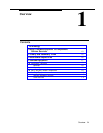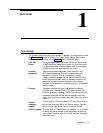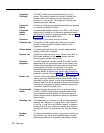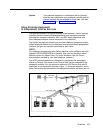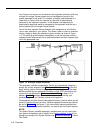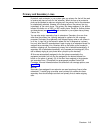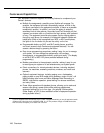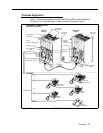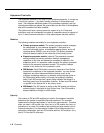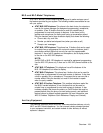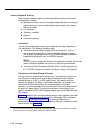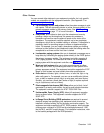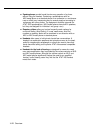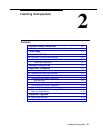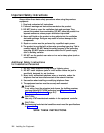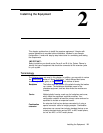
Equipment Controller
The equipment controller is the heart of your premises equipment. It is made up
of one or two carriers — the plastic housing consisting of the backplane and
cover. The backplane distributes power to the premises equipment, and has
slots where modules are placed; the cover slides onto the front of the backplane
after all the modules have been installed.
The system must have a primary carrier for support of up to 12 lines and
extensions, and can be expanded to include an expansion carrier for support of
up to 12 more lines and extensions. A fully loaded system has both carriers.
Modules
The following modules are installed in your equipment controller:
■
■
Primary processor module.
The primary processor module manages
the components of your premises equipment. It has jacks for a
music-on-hold audio source, a loudspeaker paging system, and a call
reporting device (SMDR), such as a printer. The primary processor
module is always installed in the center slot of the primary carrier.
Expansion processor module.
(optional) The expansion processor
module extends the primary processor module’s management
capabilities to the lines and extensions connected to modules in the
expansion carrier. An expansion cable connects the primary processor
module to the expansion processor module. This module is always
installed in the center slot of the expansion carrier.
206 Modules.
Each 206 module connects a maximum of two Centrex
lines and six extensions to the equipment controller. You can connect
telephones and other telecommunications devices (such as fax
machines, answering machines, or modems) to the extension jacks on
the 206 module (either directly or through your building’s extension
jacks). Each 206 module has a green power indicator that shows it is
receiving power from the equipment controller. At least one 206 module
is required in the leftmost slot of the primary carrier.
400 Module.
The 400 module is similar to the 206 module, but without
■
■
extension jacks. It has jacks for four Centrex lines. The 400 module is
always installed to the right of a 206 module.
Capacity
The number of 206 and 400 modules you install in the equipment controller
determines the number of available lines and extensions. The controller
implements the Centrex requirement of one line for each extension. Therefore,
when you install a 400 module (four lines) next to a 206 module (two lines, six
extensions) in a carrier, the combined pair provides an equal number (six) of
lines and extensions. For the maximum number of lines and extensions in a
two-carrier configuration, pair four 206 modules with four 400 modules—for a
total of 24 lines and 24 extensions.
1-8
Overview



